-
Countries
-
Data and Analysis
-
Special Focus
-
Crisis Responses
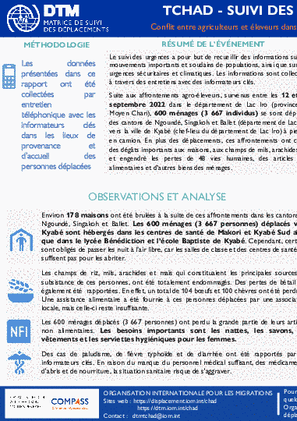
Contact
DTM Chad, dtmtchad@iom.int
Language
French
Location
Chad
Period Covered
Sep 23 2022
Sep 23 2022
Activity
- Mobility Tracking
- Event Tracking
Suite aux affrontements agro-éleveurs, survenus entre les 12 et 13 septembre 2022 dans le département de Lac Iro (province du Moyen Chari), 600 ménages (3 667 individus) se sont déplacés des cantons de Ngoundé, Singakoh et Ballet (département de Lac Iro) vers la ville de Kyabé (chef-lieu du département de Lac Iro) à pied et en camion. En plus des déplacements, ces affrontements ont causé des dégâts importants aux maisons, aux champs de mils, arachides, riz et engendré les pertes de 48 vies humaines, des articles non alimentaires et d’autres biens des ménages.
To better understand and capture how COVID-19 has been affecting global mobility, IOM developed a global database (the Mobility Restriction Monitoring, MRM) which maps, tracks, and analyses the changes and trends in operational status of and mobility restrictions at Points of Entry (PoEs) including airports, blue border crossing points (such as seaports and river crossings), land border crossing points and other key transit points and locations of internal mobility. Outside of operational status for key loca- tions of internal mobility, MRM collects data on border management and public health measures adopted at PoEs, as well as coordination systems and referral mechanisms in place at Points of Entry and some internal mobility points, as well as populations impacted by COVID-19 mobility restrictions.
Such information is meant to serve IOM member states, IOM, and its UN partner agencies in responding adequately, and in a targeted manner, to the current and evol- ving crisis period. In West and Central Africa, IOM missions were involved in providing information on the situation at the PoEs in their respective countries.
This report presents the findings from data collected on the operational status of PoEs as of 30 June 2022, with 573 Points of Entry across the region, including 417 land border crossings points, 74 airports and 82 blue border crossing points (maritime borders).
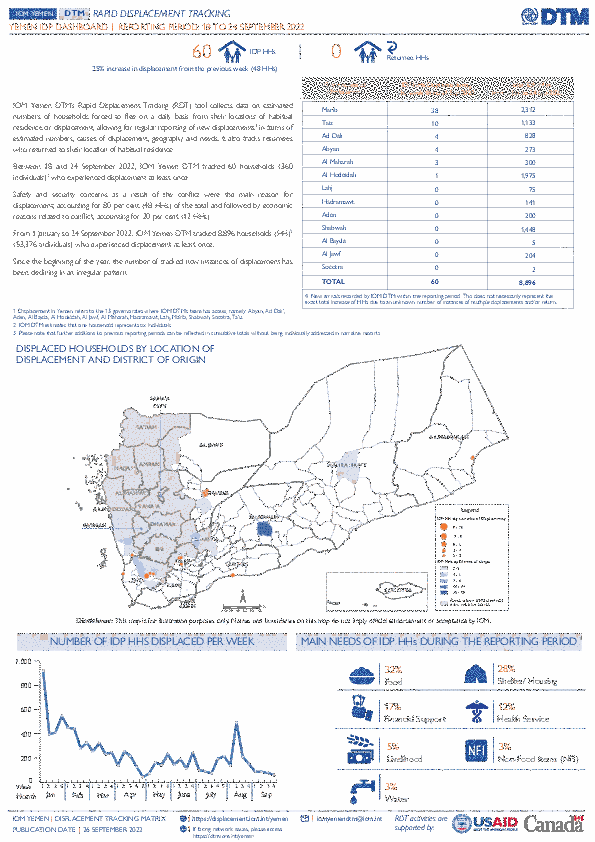
Contact
DTM Yemen, iomyemendtm@iom.int
Language
English
Location
Yemen
Period Covered
Sep 18 2022
Sep 24 2022
Activity
- Mobility Tracking
IOM Yemen DTM’s Rapid Displacement Tracking (RDT) tool collects data on estimated numbers of households forced to flee on a daily basis from their locations of origin or displacement, allowing for regular reporting of new displacements in terms of estimated numbers, geography, and needs. It also tracks returnees who returned to their location of origin.
From 1 January to 24 September 2022, IOM Yemen DTM tracked 8,896 households (HH) (53,376 Individuals) who experienced displacement at least once.
Between 18 and 24 September 2022, IOM Yemen DTM tracked 60 households (360 individuals) displaced at least once. The majority of people moved into/within the following governorates and districts:
- Marib (38 HHs) – Marib City (34 HHs), Marib (4 HHs) districts. Most displacements in the governorate originated from Shabwah and Taiz.
- Taiz (10 HHs) – Jabal Habashi (7 HHs), Al Misrakh (2 HHs), Al Makha (1 HHs) districts. Most displacements in the governorate originated from Taiz and Sanaa City.
- Abyan (4 HHs) – Khanfar (4 HHs) district. All displacements in the governorate originated from Al Hodeidah.
The majority of people moved from the following governorates and districts:
- Taiz (14 HHs) – Maqbanah (6 HHs), Sabir Al Mawadim (4 HHs), Jabal Habashi (2 HHs) districts.
- Al Hodeidah (10 HHs) – Zabid (4 HHs), Al Marawiah (2 HHs), Al Jarrahi (2 HHs) districts.
- Shabwah (10 HHs) – Ataq (10 HHs) district.
Contact
DTMRCA@iom.int
Location
Central African Republic
Activity
- Mobility Tracking
- Baseline Assessment
Period Covered
Aug 01 2022 -Sep 07 2022
A baseline assessment is a sub-component of mobility tracking. It aims to collect data on IDP, migrant or returnee population presence in a defined administrative area of the country.
Population Groups
Survey Methodology
Unit of Analysis Or Observation
Type of Survey or Assessment
Keywords
Geographical Scope
Administrative boundaries with available data
The current dataset covers the following administrative boundaries
Sep 28 2022
Print
Type
Other
Published date
Wed, 09/28/2022 - 11:13
IOM works with national and local authorities in order to gain a better understanding of population movements throughout Southern Africa. Through the setup of Flow Monitoring Points (FMPs), IOM seeks to quantify migration flows, trends and routes and to gain a better understanding of the profiles of observed individuals at entry, transit or exit points (such as border crossing posts, bus stations, rest areas, police checkpoints and reception centres). This report is an overview of the data collected in these FMPs from 1 to 31 August 2022.
Inter-regional migration from and within the Southern Africa is categorized along the following corridors. The Flow Monitoring Points (FMPs) were set-up in several key transit locations along the corridors to track the movements of passengers:
•Zimbabwe (Mutare) – Mozambique (Manica)
•Zimbabwe – Zambia (Chirundu)
•Zimbabwe – Botswana (Plumtree)
•Zimbabwe (Beitbridge) – South Africa
•Malawi (Mchinji) - Zambia (Mwami)
•Malawi (Karonga ) – United Republic of Tanzania
•Malawi (Mwanza) – Mozambique (Zobue)
•Malawi (Mulanje) – Mozambique
•Mozambique (Ressano Garcia) – South Africa
•Democratic Republic of the Congo (Kasumbalesa) – Zambia
Over the reporting period a total of 76,756 movements were observed across 48 FMPs in the region. The Zimbabwe – South Africa corridor hosted the largest number of movements with 33,123 (43%) followed by the Democratic Republic of Congo (Kasumbalesa) – Zambia corridor with 11,566 (15%) and the (Malawi (Mwanza) – Mozambique (Zobue) corridor with 9,775 movements reported (13%).
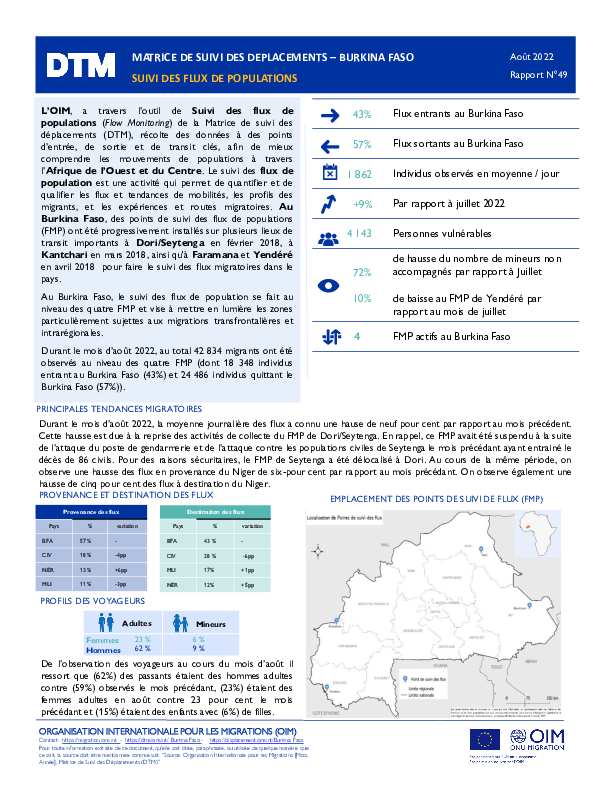
Contact
Regional Office Dakar, RODakar-DataResearch@iom.int
Language
French
Location
Burkina Faso
Period Covered
Aug 01 2022
Aug 31 2022
Activity
- Flow Monitoring
Afin de mieux comprendre les mouvements et tendances migratoires en Afrique de l’Ouest et du Centre, l’OIM, à travers la Matrice de suivi des déplacements (Displacement Tracking Matrix, DTM), met en œuvre l’activité de Suivi des flux de populations (Flow Monitoring, FM).
Au Burkina Faso, la DTM recueille des données au niveau de 4 Points de suivi des flux (Flow Monitoring Points, FMP) que sont Dori/Seytenga, Kantchari, Faramana et Yendéré répartis dans 4 régions afin d’obtenir une meilleure compréhension de l’ampleur, des tendances, des caractéristiques socio-démographiques et des parcours des flux de voyageurs traversant ces différents points.
Ce rapport présente les données recueillies dans le cadre des activités d’enregistrement des flux durant le mois d'août 2022.
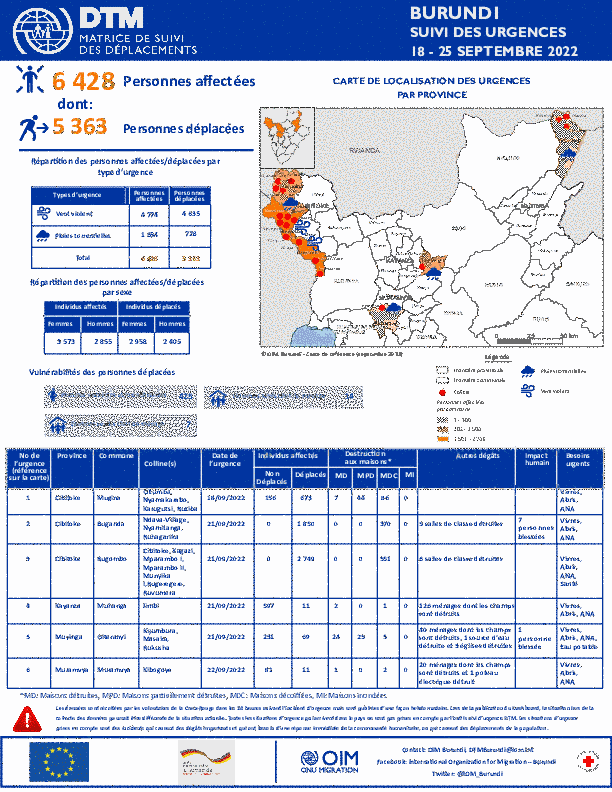
Contact
DTM Burundi, DTMBurundi@iom.int
Language
French
Location
Burundi
Period Covered
Sep 18 2022
Sep 25 2022
Activity
- Mobility Tracking
- Event Tracking
La DTM a identifié 6 428 personnes (1 281 ménages) affectées dont 5 363 personnes (1 055 ménages) déplacées par les pluies torrentielles et vents violents dans les provinces de Cibitoke, Kayanza, Muramvya et Muyinga.

Contact
oimcostarica@iom.int
Language
Spanish
Location
Costa Rica
Period Covered
Aug 01 2022
Aug 31 2022
Activity
- Survey
- Flow Monitoring
Actualmente, hay presencia de personas migrantes que cruzan de manera irregular la frontera norte de Costa Rica, muchas de ellas tienen familiares, amistades y/o son reconocidas por las personas empleadoras que las han contratado en años anteriores, por lo que no realizan los trámites migratorios; este grupo se encuentra conformado principalmente por personas originarias de
Nicaragua que ingresan a trabajar principalmente en labores de agricultura, ganadería y construcción. Por otro lado, desde el cierre de fronteras al flujo controlado de personas migrantes en situación de movilidad por las Américas, de 16 de marzo de 2020 en el contexto de la pandemia ocasionada por la COVID – 19, se ha detectado el tránsito en diferentes horarios de personas de este flujo que optan por migrar de manera irregular desde Panamá hacia Costa Rica y a través de Centroamérica, con destino final los países del norte de América. El Comité Nacional de Emergencias (CNE) ha comunicado en varias ocasiones alerta verde y amarilla en todo el país por lluvias provocadas por ondas tropicales y condiciones atmosféricas inestables. Esto implicó disminución del flujo migratorio y dificultad de trabajo de campo del equipo encuestador. Se reporta que el camino de los pasos fronterizos de todos los sitios de monitoreo (especialmente en La Trocha y Las Tablillas) se encuentran en mal estado esto debido a las fuertes lluvias durante todo el mes, esta situación implica que el flujo migratorio se desvíe hacia otras rutas. Se reporta constante vigilancia fronteriza en territorio nicaragüense durante en horas del día, lo que implica que las personas que componen el flujo migratorio decidan cruzar la frontera en horas de la noche y/o por otras rutas para evitar ser rechazadas en suelo nicaragüense por ingresar por un paso fronterizo no oficial.
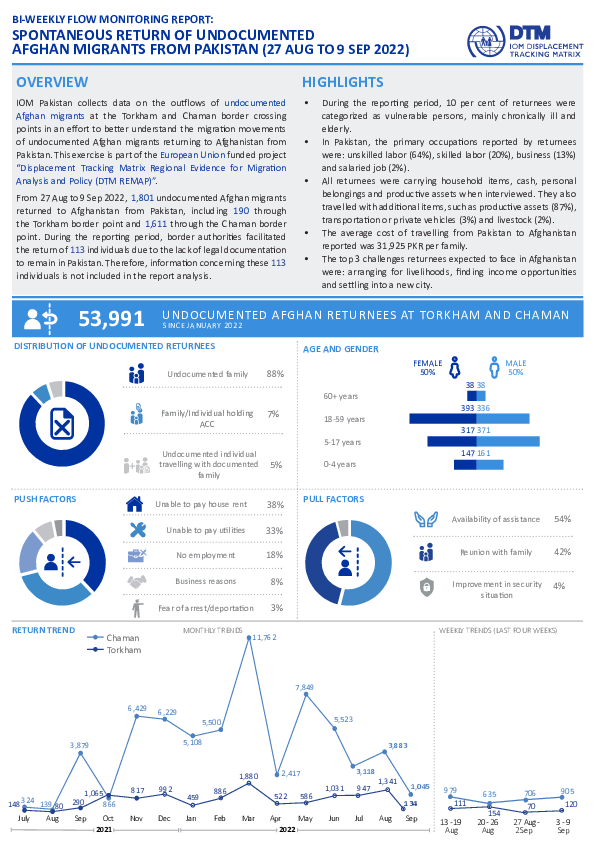
Contact
DTM Pakistan, iomisbdtmremapteam@iom.int
Language
English
Location
Pakistan
Period Covered
Aug 27 2022
Sep 09 2022
Activity
- Flow Monitoring
IOM Pakistan collects data on the outflows of undocumented Afghan migrants at the Torkham and Chaman border crossing points in an effort to better understand the migration movements of undocumented Afghan migrants returning to Afghanistan from Pakistan. This exercise is part of the European Union funded project “Displacement Tracking Matrix Regional Evidence for Migration Analysis and Policy (DTM REMAP)”.
From 27 Aug to 9 Sep 2022, 1,801 undocumented Afghan migrants returned to Afghanistan from Pakistan, including 190 through the Torkham border point and 1,611 through the Chaman border point. During the reporting period, border authorities facilitated the return of 113 individuals due to the lack of legal documentation to remain in Pakistan. Therefore, information concerning these 113 individuals is not included in the report analysis.


